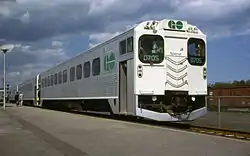Hawker Siddeley RTC-85SP/D
Hawker Siddeley RTC-85/SP/D were a series of railway coach and diesel multiple units manufactured by Hawker Siddeley Canada for GO Transit, largely based on the H-series subway cars which they built for the Toronto Transit Commission.
| RTC-85 SP or RTC-85SPD | |
|---|---|
 Hawker Siddeley RTC-85 series cars on a Go Transit train in 1968. | |
| Manufacturer | Hawker Siddeley |
| Built at | Can-Car Rail Plant Fort William (Thunder Bay), Ontario |
| Family name | Hawker Siddeley H-series |
| Replaced | Hawker Siddeley Canada Bi-Level Coach I and II |
| Entered service | 1968-1980s |
| Refurbished | 1975 by Ontario Northland Railway |
| Number built | 117 |
| Number in service | 110 |
| Number scrapped | 7 |
| Formation | as self-propelled unit and later as cab cars by GO Transit; ONR operates them as passenger cars |
| Fleet numbers | GO Transit - 1000-1031, 100-107, (C750-C757 and 4700-4731 and renumbered 9850-9857 and 9900-9931 1970), 108-116 (D700-D708, then renumbered 9825-9833 1970), 1032-1045 (4740-4753, then renumbered 9932-9945 1970), 1046-1075 (9946-9975 1974), 1076-1105 |
| Capacity | 92 seated |
| Operator(s) | GO Transit Ontario Northland Railway Agence métropolitaine de transport (now Exo (public transit)) MARC Train |
| Specifications | |
| Car body construction | Aluminum |
| Car length | approximately 85 ft (25.91 m) |
| Width | approx. 3.14 m (10 ft 3 5⁄8 in) |
| Doors | 4 sets (2 sets per side) per car |
| Track gauge | 1,435 mm (4 ft 8 1⁄2 in) standard gauge |
Their name was derived as follows: Rapid Transit Coach 85' long Self-Propelled Double-end.[1]
47 92-seat RTC cars were ordered and delivered to GO Transit in 1967, with 7 of them being built as single-level self-propelled units # D700, D701, D702 to D708 (later renumbered as 9825-9826, 9827-9833), 8 built as unpropelled cab cars (C750 to C757, later 9850 to 9857) and the remaining 32 as regular coaches (4700 to 4731, later 9900 to 9931). With additional cars being built until 1976, the eventual total of the fleet would number 117 cars.[2] All cars were built at Hawker's Thunder Bay, Ontario plant. In 1975 the self-propelled cars were demotored and used as cab cars.
All cars were withdrawn from service and sold off by GO Transit by 1995 with 6 scrapped and remaining sold to other operators:
- 23 to Ontario Northland Railway, primarily used on the now-retired Northlander
- 92 to Agence métropolitaine de transport (now RTM) (now retired)
- 11 cars to Pandrol-Jackson Electric Tamper and Equipment Company as crew-cars for rail grinding operations
In 2017, Car 104 was re-purchased restored by GO Transit to celebrate their 50th anniversary.[3] The cab car is now displayed at the Toronto Railway Museum in downtown Toronto.[4][5]
Gallery
.jpg.webp) Car 104 at the Toronto Railway Museum
Car 104 at the Toronto Railway Museum The cars on the AMT
The cars on the AMT.jpg.webp) RTC cars used with bi-level coaches.
RTC cars used with bi-level coaches.
References
- "GO Transit, Government of Ontario, A Brief History". Old Time Trains. Retrieved June 19, 2017.
- http://www.exporail.org/can_rail/Canadian%20Rail_no280_1975.pdf
- http://trn.trains.com/news/news-wire/2017/05/16-go-transit-restores-cab-car-to-mark-50th-anniversary
- GO Transit [@GOtransit] (14 May 2017). "It's finally here! Please welcome the latest addition to the @TORailwayMuseum: a restored original GO cab car from…" (Tweet) – via Twitter.
- Toronto Railway Museum [@TORailwayMuseum] (13 May 2017). "The Toronto Railway Museum was pleased to welcome a very special part of our rail heritage to Roundhouse Park today…" (Tweet) – via Twitter.
| Wikimedia Commons has media related to Hawker Siddeley RTC-85. |